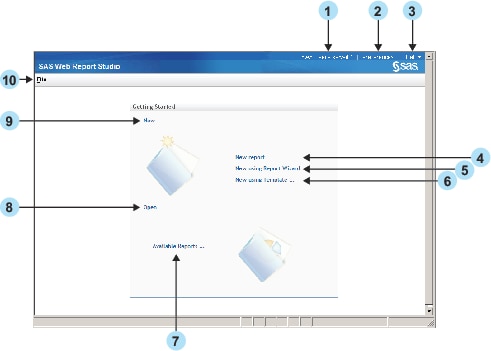Your First Look at the SAS Web Report Studio User Interface
After
you log on to SAS Web Report Studio, you see the Welcome window. Here are the main features of the Welcome window.
The Welcome Window

1Click Log Off to exit SAS Web
Report Studio.
2Click Preferences to personalize
your use of SAS Web Report Studio.
3Select the Help menu to get
help on using SAS Web Report Studio. For more information,
see How to Get Help for SAS Web Report Studio.
4Click New report to create
a new report using the Edit tab. For more information,
see Edit Mode Interface.
5Click New Using Report Wizard to access the Report Wizard. The wizard guides you in defining a
query; selecting a table and graph for the layout; and adding optional
features such as group breaks, a header, and a footer. For more information,
see Use the Report Wizard.
6Click New Using Template to
access the Select a Template dialog box.
When you select a template, you start creating your report with a
predefined layout.
7Click Available Reports to
access the Open dialog box. The Open dialog box enables you to search for reports, and
it lists reports, stored processes, folders, and data sources. For more information,
see Open Dialog Box.
8Click Open to access the Open dialog box. The Open dialog
box enables you to search for reports, and it lists reports, stored
processes, folders, and data sources. For more information,
see Open Dialog Box.
9Click New to create a new report
using the Edit tab. For more information,
see Edit Mode Interface.
10Select the File menu to access
task options, such as Open and Manage Files.